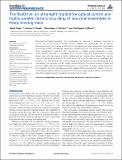The flexDrive: an ultra-light implant for optical control and highly parallel chronic recording of neuronal ensembles in freely moving mice
Author(s)
Voigts, Jakob; Pritchett, Dominique L.; Moore, Christopher I.; Siegle, Joshua Handman
DownloadVoigts-2013-The flexDrive_ an ul.pdf (2.359Mb)
PUBLISHER_POLICY
Publisher Policy
Article is made available in accordance with the publisher's policy and may be subject to US copyright law. Please refer to the publisher's site for terms of use.
Terms of use
Metadata
Show full item recordAbstract
Electrophysiological recordings from ensembles of neurons in behaving mice are a central tool in the study of neural circuits. Despite the widespread use of chronic electrophysiology, the precise positioning of recording electrodes required for high-quality recordings remains a challenge, especially in behaving mice. The complexity of available drive mechanisms, combined with restrictions on implant weight tolerated by mice, limits current methods to recordings from no more than 4–8 electrodes in a single target area. We developed a highly miniaturized yet simple drive design that can be used to independently position 16 electrodes with up to 64 channels in a package that weighs ~2 g. This advance over current designs is achieved by a novel spring-based drive mechanism that reduces implant weight and complexity. The device is easy to build and accommodates arbitrary spatial arrangements of electrodes. Multiple optical fibers can be integrated into the recording array and independently manipulated in depth. Thus, our novel design enables precise optogenetic control and highly parallel chronic recordings of identified single neurons throughout neural circuits in mice.
Date issued
2013-05Department
Massachusetts Institute of Technology. Department of Brain and Cognitive SciencesJournal
Frontiers in Systems Neuroscience
Publisher
Frontiers Research Foundation
Citation
Voigts, Jakob, Joshua H. Siegle, Dominique L. Pritchett, and Christopher I. Moore. “The flexDrive: an ultra-light implant for optical control and highly parallel chronic recording of neuronal ensembles in freely moving mice.” Frontiers in Systems Neuroscience 7 (2013).
Version: Final published version
ISSN
1662-5137